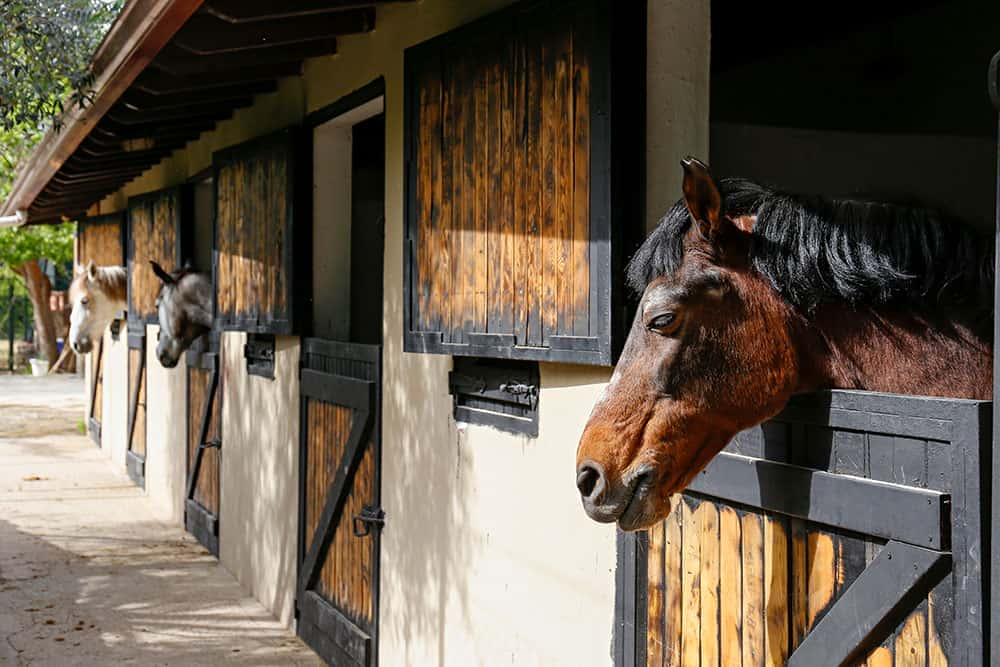Livery stables (often known as livery yards) are working stable facilities that are privately owned but opened to other horse owners as a place to house their horses in return for a fee. Livery stables were common in the 19th and early 20th centuries, when horses played a significant role in daily life, serving as a primary mode of transportation and as work animals. These establishments offered a range of services related to horses, and there were different types of livery stables to cater to various needs.
Today, livery yards can vary significantly in the services they offer, the facilities they provide, and their cost. These differences can include the type of livery services (full, part, or DIY), the quality of facilities and amenities, the availability and schedule of turnout, the feeding and grooming options, the presence of trainers or instructors, access to healthcare services, specialisation in specific riding disciplines, the social atmosphere, and the associated costs. Whether you require mobile field shelters, wooden stable buildings, or other types of timber buildings, there is a livery yard to suit your needs.
When selecting a livery yard, horse owners should carefully consider their individual needs and preferences. Visit prospective yards, consult with current boarders, and thoroughly review the terms of the livery agreement to ensure a suitable fit for both horse and owner. Here are the four main categories of livery yards:
Full livery
Full livery is a comprehensive horse boarding service provided by a stable or equestrian facility. When a horse is placed in full livery, the facility takes on the responsibility of caring for the horse’s needs in a holistic manner. Here’s what is typically included in a full livery service:
- Stabling. The facility provides a stable or stall where the horse can reside. This stall is usually cleaned and maintained by the stable staff.
- Feeding. The stable staff is responsible for feeding the horse according to a predetermined diet. This includes providing hay, grain, and any necessary supplements. Special dietary requirements or restrictions can often be accommodated.
- Turnout. The horse is turned out to pasture or an enclosed area for exercise and socialisation. The frequency and duration of turnout can vary depending on the facility and the horse’s needs.
- Grooming. Basic grooming and care are typically included. This may involve brushing the horse, cleaning hooves, and maintaining the horse’s coat and mane.
- Exercise. Some full livery services include exercise or training for the horse, which may include riding, lunging, or other forms of exercise to keep the horse fit and well-behaved.
- Healthcare. Facilities may oversee routine healthcare tasks such as deworming, vaccinations, and regular health checks by a veterinarian or farrier. Owners are usually responsible for covering the costs of these services.
- Tack and equipment. In some cases, the facility may provide tack (saddles, bridles, etc.) and equipment, while in others, the owner is expected to provide their own.
- Supervision. The stable staff keeps a close eye on the horse’s well-being and can quickly respond to any health or behavioural concerns.
- Blanketing. Depending on the weather, the stable may provide blankets or sheets to keep the horse comfortable and protected from the elements.
- Additional services. Some full livery facilities offer additional services, such as bathing, clipping, and show preparation, for an extra fee.
Full livery is an attractive option for horse owners who have limited time or expertise to care for their horses themselves. It provides a level of convenience and peace of mind, knowing that professionals are taking care of all aspects of the horse’s well-being. However, it can be more expensive than other boarding options like partial livery or self-care, as the facility assumes a greater share of the responsibilities. When considering full livery, it’s also essential to think about stable lighting tips and planning permission for existing stable blocks.
Part livery
Part livery, also known as partial livery or part boarding, is a horse boarding arrangement in which the horse owner and the livery yard (the facility where the horse is stabled) share the responsibilities of caring for the horse. In a part livery arrangement, the owner retains some level of involvement and responsibility for the care of their horse, while the livery yard staff also provide certain services. The specific terms of a part livery arrangement can vary widely depending on the agreement between the owner and the livery yard, but here are some common features:
- Stabling. The livery yard provides a stall or stable for the horse to reside in. The owner may have the option to choose the type of accommodation for their horse.
- Feeding. The livery yard staff typically provide basic feeding services, including hay, grain, and water. The specific feeding regimen may be agreed upon between the owner and the yard.
- Turnout. Depending on the arrangement, the owner may be responsible for arranging and overseeing the horse’s turnout (exercise in a pasture or paddock), or the livery yard may handle this aspect of care.
- Grooming and care. The owner may have the option to groom and care for the horse themselves or request that the livery yard staff take care of these tasks.
- Healthcare. Owners are typically responsible for the horse’s routine healthcare, such as vaccinations, deworming, and farrier visits. However, the livery yard may assist with scheduling and coordinating these services.
- Exercise and riding. In many part livery arrangements, the owner retains the right to ride and exercise their horse. Some yards may offer riding facilities, while others may allow owners to take their horses off-site for exercise.
- Tack and equipment. Owners are usually responsible for providing and maintaining their horse’s tack (saddle, bridle, etc.) and equipment. The livery yard may offer storage space for these items.
Part livery arrangements offer flexibility to horse owners who want to be involved in their horse’s care but may not have the time or resources to provide full care themselves. It can also be a good option for those who want to learn more about horse care and management while receiving support from experienced livery yard staff. This arrangement often works well for those who need specific stable designs or timber framed buildings that suit their requirements.
The specifics of a part livery agreement should be clearly outlined in a contract or agreement between the horse owner and the livery yard to avoid misunderstandings and ensure that both parties are aware of their respective responsibilities and the services provided.
Do it yourself livery
DIY livery is a popular option as it generally entails the yard owners providing the grazing and stabling facilities but the horse owner meeting the needs of the horse, such as feeding, mucking out, grooming, exercising, etc. These livery yards are not typically managed or staffed, so all the responsibility for the horse falls on its owner. It is a much more cost-effective stabling option, and many horse owners prefer (and enjoy) personally tending to their horses rather than passing the responsibility onto someone else. Whether you need a simple horse stable or more comprehensive facilities, DIY livery can be a great option.
Working livery
Working livery stables such as riding schools or equestrian centres, offer a variety of services related to horses, often with a focus on providing riding lessons and horse training. Aside from working livery yards, the main types of working livery stables include:
- Lesson and riding schools. These stables primarily offer riding lessons to individuals of all ages and skill levels. They often have a team of qualified instructors and a selection of well-trained lesson horses or ponies. Riding schools may cater to various riding disciplines such as English riding (e.g. dressage, show jumping), or even specialised disciplines like vaulting or polo.
- Horse training facilities. Some working livery stables focus on horse training, including starting young horses, improving the skills of experienced horses, or addressing behavioural issues. These facilities may offer training for both recreational and competitive riders.
- Competition and show barns. These stables specialise in preparing horses and riders for horse shows, competitions, and events. They may have experienced trainers and access to top-notch facilities to help riders excel in their chosen discipline.
- Therapeutic riding centres. Some working livery stables focus on therapeutic riding programs. These programs use horseback riding as a form of physical, emotional, or psychological therapy for individuals with disabilities or special needs. The horses are carefully selected and trained to work with riders who have various challenges.
- Trail riding centres. Working livery stables in scenic or rural areas may emphasise trail riding experiences. They provide guided trail rides for tourists and visitors, often on well-trained horses that are suitable for riders with varying levels of experience.
- Pony clubs. Pony clubs are typically aimed at children and young riders. These clubs provide riding lessons, education about horse care and management, and opportunities for young equestrians to participate in various equestrian activities and competitions.
- Breeding and stud farms. While not exclusively working livery stables, some breeding and stud farms may offer training and boarding services for mares, stallions, and young horses. These facilities focus on breeding and raising horses for specific purposes, such as racing, sport, or leisure.
Each type of working livery stable may have a distinct focus, clientele, and set of services. Horse enthusiasts can choose the type of working livery stable that best aligns with their riding goals, whether it’s learning to ride, improving their skills, participating in competitions, or simply enjoying recreational riding. The right stable manufacturer for stable designs can make a significant difference in the functionality and aesthetics of these facilities.
Whether you are looking for a field shelter, a single private stable, an American barn stable, a whole livery yard, or another timber structure, we can help. Request a brochure for inspiration or contact us directly at your convenience. From stable lighting tips to planning permission for existing stable blocks, our experts are here to assist you in every step of your equestrian journey.

Get in touch
Want to know more about choosing low-cost, high-quality stables? We’re happy to answer all your questions. Call 01233 740944, email info@nationalstables.co.uk or send us a message and we will respond ASAP.




